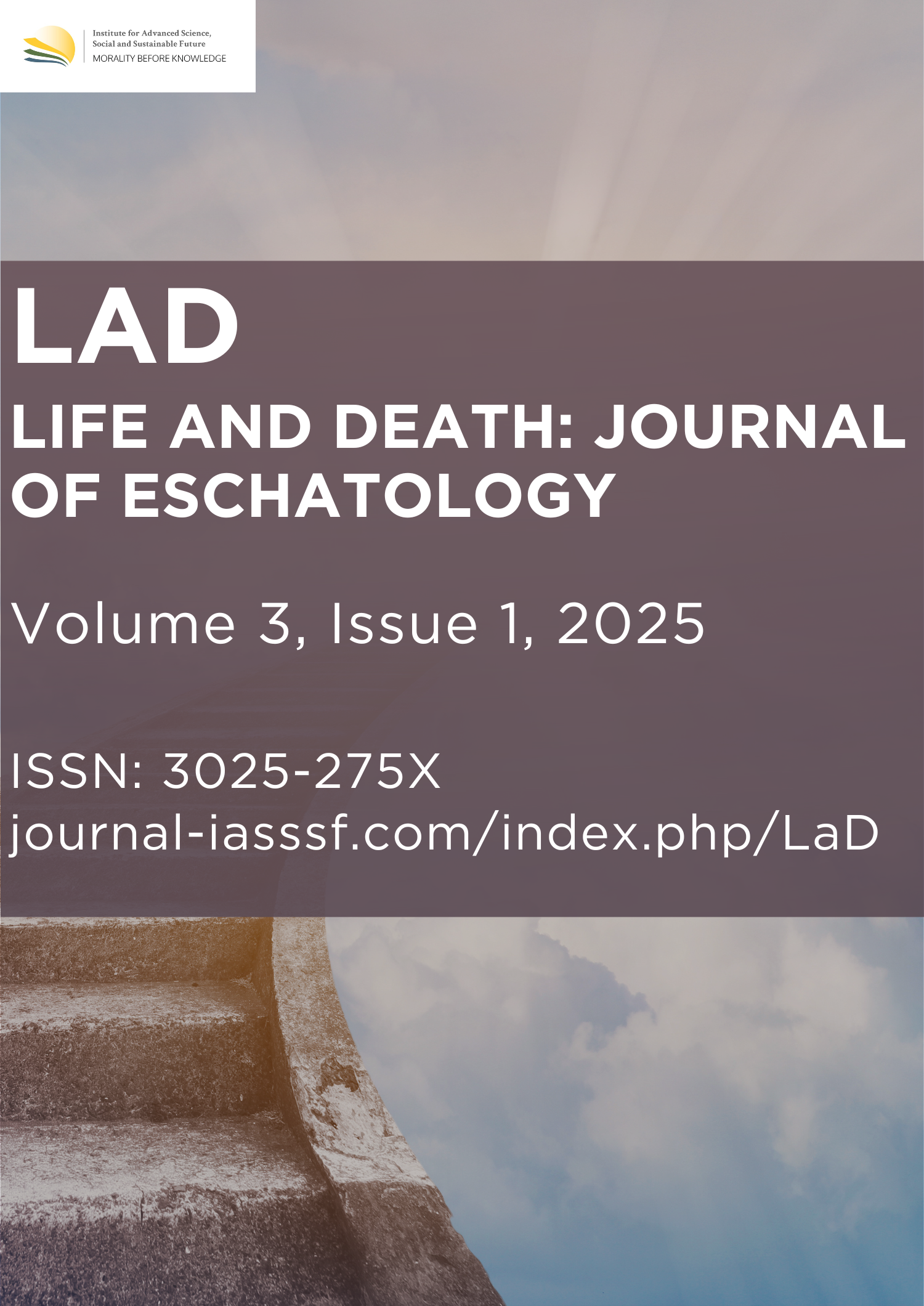Baris wayang dance: Ritual meaning and community perception in balinese hinduism
DOI:
https://doi.org/10.61511/lad.v3i1.2025.2160Keywords:
deva yajña ceremony, line wayang dance, religiosityAbstract
Background: The Baris Wayang Dance is only performed at the Dalem Beads Upgrading Great Lumintang Temple. This dance is a combination of dance, karawitan , vocal, puppetry, and costume, and is only performed upon the God's vision who lived at the temple occurred. Methods: This study uses a qualitative method with a descriptive-analytical approach. To obtain valid data in the field, this study used observation techniques, interviews with key informants and the community in Lumintang village, and literature studies. To analyze the above problems, religious and semiotic theories were used. Findings: The results of the study show that, the form of the Line Wayang Dance performance is composed of the structure of kawitan , pepeson , pengumbang , and pengluwuran ; performed on the basis of the God's vision who resides in the temple; danced by nine dancers while singing the purifying song, and holding puppets that represent Gods; also accompanied by traditional music, the public's perception of this dance performance is understood as a means of purifying and offering sacred offerings to God, the denotative meaning of this performance is reflecting the story of wayang and Hindu religious symbols; this dance connotatively represents the cycle of human life, a form of communication between people and the divine; and at the mythical level it is interpreted as the embodiment of the God's vision. Conclusion: Based on this phenomenon, the problems in this study can be formulated as follows, what is the form of the Baris Wayang Dance performance, what is public perception of the Baris Wayang Dance performance, what is the meaning contained in the performance from a Hindu theological perspective. Novelty/Originality of this article: The novelty of this study lies in its unique exploration of the Baris Wayang Dance as a sacred, vision-inspired ritual that integrates multiple traditional art forms to symbolize divine communication and the human life cycle within a specific Balinese temple context.
References
Ahmad, S. (2021). Totem, ritual dan kesadaran kolektif: Kajian teoritik terhadap pemikiran keagamaan Emile Durkheim. Al-Adyan: Journal of Religious Studies, 2(2), 153–161. https://doi.org/10.15548/al-adyan.v2i2.3384
Armayani, R. T. (2021). Traditional Balinese Dance Creativity as Media of Worshipping God in Hindu Religious Practices. Widya Sandhi: Jurnal Kajian Agama, Sosial dan Budaya, 12(1), 38-48. https://doi.org/10.53977/ws.v0i0.312
Ardiyani, L. P. C., Pitriani, K., & Jero, N. W. J. (2025). Rejang Pedawa dance as a medium for ethnopedagogical-based adolescent learning. Dharmakirti: International Journal of Religion, Mind and Science, 2(2), 137-151. https://doi.org/10.61511/ijroms.v2i2.2025.1311
Bandem, I. M., & de Boer, F. E. (1995). Kaja and kelod: Balinese dance in transition. Oxford University Press.
Dewi, L., Sariyasa, & Gede Suweken. (2022). Ethnomathematics in Balinese Dance Movements and Its Potential for Learning. International Journal of Science and Research (IJSR), 11(10), 207-218. https://doi.org/10.21275/SR22731071301
Denpasar City Government. (2024). Profile of Dauh Puri Kaja Village, North Denpasar District, Denpasar City.
Denpasar City Cultural Office. (2014). Baris Wayang: Local wisdom growing in Banjar Lumintang.
Denpasar City Government. (2019). Baris Wayang: Pementasan tari sangat sulit dilaksanakan saat ini. https://www.denpasarkota.go.id/wisata/pementasan-tari-baris-wayang-sangat-sulit-di-laksanakan-saat-ini
Dibia, I. W. (2012). Balinese dance, drama & music: A guide to the performing arts of Bali. Tuttle Publishing.
Erawati, N. M. P. (2024). Filsafat tari dalam kebudayaan Bali. Widyadari, 25(1), 173-182. https://doi.org/10.59672/widyadari.v25i1.3663
Gautama, W. B. (2009). Katuturaning Barong Swari Lan Dalang. Paramita.
Jemiwi, J., & Dharma, N. K. S. A. (2025). Hidup Selaras dengan Dharma: Langkah Kembali ke Rumah Jiwa. PT. Dharma Pustaka Utama.
Isaacs, D. (2020). Human rites and rituals. Journal of Paediatrics and Child Health, 56(7), 1001–1002. https://doi.org/10.1111/jpc.14786
Kaswara, K. A. J. (2016). Nilai-Nilai Pendidikan Karakter Dalam Tari Baris Wayang Di Banjar Lumintang, Desa Dauh Puri Kaja, Kecamatan Denpasar Utara. Institut Seni Indonesia Denpasar.
Kesiman, M. W. A., Maysanjaya, I. D., Pradnyana, A., Sunarya, G., & Suputra, P. H. (2020). Profiling Balinese Dances with Silhouette Sequence Pattern Analysis. 2020 International Conference on Computer Engineering, Network, and Intelligent Multimedia (CENIM). IEEE. https://doi.org/10.1109/CENIM51130.2020.9297893
Koentjaraningrat. (1974). Culture, mentality, and development. Gramedia.
Koten, I. L., & Pramartha, C. R. A. (2020). Semantic Representation of Balinese Traditional Dance. Jurnal Elektronik Ilmu Komputer Udayana, 8(4), 411-419. https://doi.org/10.24843/JLK.2020.V08.I04.P07
Linggih, I. N. (2024). Golden wayang in Bali, Hindu Nusantara cultural civilization. Kamaya: Journal of Religious Studies, 7(4), 129. https://doi.org/10.37329/kamaya.v7i4.3848
Matthew, M., Miles, M. B., & Saldana, J. (2014). Qualitative data analysis: A methods sourcebook (3rd ed.). Sage Publications.
Papp, M. (2020). Rite/ritual. In The Blackwell Encyclopedia of Sociology. Wiley. https://doi.org/10.1002/9781405165518.wbeosr071.pub2
Pratiwi, C. A. (2017). Harai: A study of the concept of Keontjaraningrat religion. Japanology, 5(2), 173–185. https://journal.unair.ac.id/download-fullpapers-jplg3db990f80afull.pdf
Purwanta. (2021). Semiotics of communication in Baris Keraras dance performance in Aci Tulak Tunggul ceremony at Taman Ayun Temple, Mengwi Traditional Village. Journal of Hindu Communication Science, 1(2), 125–133. https://doi.org/10.25078/ANUBHAVA.V1I2.2981
Röttger-Rössler, B. (2020). The emotional meaning of ritual. In A. Michaels & C. Wulf (Eds.), Emotions in rituals and performances: South Asian and European perspectives on rituals and performativity (pp. 41–54). Routledge India. https://doi.org/10.4324/9780367818357-4
Rossano, M. J. (2020). Ritual as resource management. Philosophical Transactions of the Royal Society B: Biological Sciences, 375(1805), 20190429. https://doi.org/10.1098/rstb.2019.0429
Soedarsono. (1978). Introductory training on dance knowledge and dance composition. Indonesian Dance Arts Academy.
Spitzer, M. (2022). Rituale: Kultur und Psychologie, Pro und Kontra. Nervenheilkunde, 41(6), 374–380. https://doi.org/10.1055/a-1755-7982
Storyteller. (2023, October 2). Semiotika jadi? Stories from Briefer. https://stories.briefer.id/2023/10/02/semiotika-jadi/
Silva, J. G. C. da. (2024). Scientific Research: An Introduction. B P International. https://doi.org/10.9734/bpi/mono/978-81-976007-6-0
Suarta, M. (2014). Teori Sastra. Rajawali Pers.
Suarjata, I. B. K. (2023). Wali Baris Bugbug dance at Dalem Gede Selaungan Temple, Bangli District. Pangkaja Hindu Religion Journal, 26(2), 150–159. http://dx.doi.org/10.25078/pjah.v26i2.2685
Sugiyono, P. D. (2020). Quantitative, qualitative, and R&D research methods. Alfabeta.
Sumardjo, J. (2000). Philosophy of art. ITB.
Sustiawati, N. L. (2011). Knowledge of Balinese dance arts. PT Empat Warna Komunikasi.
Umar, H. (2013). Research methods for theses and dissertations. Rajawali.
Watson-Jones, R. E., Wen, N. J., & Legare, C. H. (2021). The psychological foundations of ritual learning. In M. J. Gelfand, C. Chiu, & Y. Y. Hong (Eds.), Advances in culture and psychology (Vol. 8, pp. 83–109). Oxford University Press. https://doi.org/10.1093/OSO/9780190079741.003.0004
Wisnawa, D. K. (2018). Religiusitas Pementasan Tari Baris Kupu-kupu pada Upacara Pujawali di Pura Dalem Dasar Banjar Sema Desa Pakraman Bungkulan Kecamatan Sawan Kabupaten Buleleng. Widya Duta: Jurnal Ilmiah Ilmu Agama dan Ilmu Sosial Budaya, 13(1), 84-96. http://dx.doi.org/10.25078/wd.v13i1.438
Wastawa, I. W. (2021). Bali: Nationalism in religion. The Journal Publishing.
Yudabakti. (2007). Filsafat seni sakral dalam kebudayaan Bali. Paramita.
Downloads
Published
How to Cite
Issue
Section
Citation Check
License
Copyright (c) 2025 Made Satyawan, I Ketut Wisarja, Ida Ayu Putu Bintang

This work is licensed under a Creative Commons Attribution 4.0 International License.
















